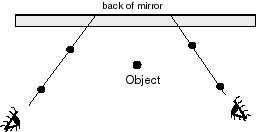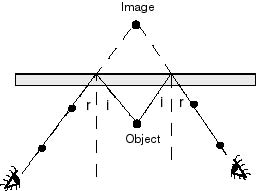Plane Mirrors
I. Assessing Prior Knowledge:
- What kind of image is in a plane mirror:
- Are there any "rules" or "laws" that will us generalize about plane mirrors?
II. Exploring - Short lab:
- Set up a plane mirror so that it perpendicular to the table (not tilted). Draw a line on the back of the mirror, where the silvered part is.
- Place an object pin in front of the mirror. Can you see it in the mirror as you move around?
- Close one eye and sight toward the "image" that you see in the mirror. Place 2 pins in front of that image, so that the 2 pins and the image look like one pin. Mark those spots "1" and "1".

- Move your head and repeat, labeling the pin spots as "2" and "2". Do it a third time.
- Extend the 3 lines so that they meet. Where is that? That is where the image seemed to be from all 3 views. What did you discover about where the image is?
- How far do you think that the image is from the mirror? Measure and compare to object distance.
What did you find?
- Use a different color pen and mark the actual path that light took from the object to the mirror and then to your eye.
- Draw the perpendicular to the mirror at the reflection spot for that image. Measure the angle of incidence (where light hits mirror) and angle of reflection (where light reflects to your eye. Measure the angles next to the perpendicular, not the ones next to the mirror. (This is important when you have curved mirrors.)

- What did you discover?
Extension:
- Place 2 plane mirrors at right angles to each other on the table. Check the angle carefully.
- How many images do you see? Can you trace the path of light for each?
- Hold a small piece of paper with writing to make each image. Which are reversed and which are not?
Can you explain?
- The middle image is different. Mark lines of sight as you did above. Use what you learned about the angles of incidence and reflection. Explain how that image was formed.
- Where are right-angle mirrors used? You see some every day!
- Move those mirrors so that the angle between them is 75o, 60 o, 45 o, 30 o, 15 o, etc. Is there a pattern relating the number of images to the angle?
IV. Applying Your Knowledge: Answer these
Brainteasers.
Mirrors
15. What is the length of a plane mirror flat against the wall that you would need to see all of yourself?
16. Do mirrors reflect 100% of the light hitting them? How can you prove it?
17. What is true about the center image in 2 mirrors perpendicular to each other? Where is this idea used in everyday life?
18. A man approaches a mirror at a speed of 2 m/s. At what speed does he approach his own reflection?
19. How do rearview mirrors change for day and night?
- Index for Optics.
- All S.F. Bay Area PTRA Workshops.
Andria Erzberger
2/1/01



